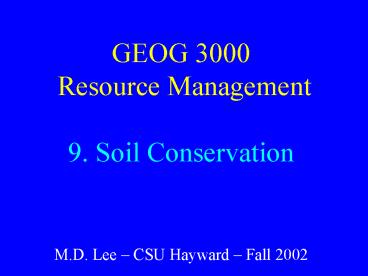GEOG 3000 Resource Management 9' Soil Conservation - PowerPoint PPT Presentation
1 / 14
Title:
GEOG 3000 Resource Management 9' Soil Conservation
Description:
Soil conservation can be achieved through effective crop management and through ... To see these, check out: http://www.ctic.purdue.edu/Core4/CT/Choices/Choices.html ... – PowerPoint PPT presentation
Number of Views:34
Avg rating:3.0/5.0
Title: GEOG 3000 Resource Management 9' Soil Conservation
1
GEOG 3000 Resource Management9. Soil
Conservation
- M.D. Lee CSU Hayward Fall 2002
2
Soil Conservation Approaches
- Soil conservation can be achieved through
effective crop management and through the use of
physical structures. - The USDA encourages farmers to practice a series
of best management practices. To see these, check
out - http//www.ctic.purdue.edu/Core4/CT/Choices/Choice
s.html
3
How to Conserve Soils
- A critical element in most soil erosion controls
is the prevention of the uncontrolled movement of
water across a sloping soil surface. - Similarly, efforts against wind erosion are
designed to reduce wind velocity and surface
shear above a soil surface. - Controls also seek to boost soil cohesiveness and
increase surface friction coefficients.
4
Predicting Soil Loss
- Soil scientists have had great success with the
RUSLE (see p 147 CRO). - A RKLSCP
- Where A soil loss, R rainfall erosivity, K
erodibility of soil, L length of slope, S
steepness of slope, C cover-type and P
conservation BMP. - R, K, L and S are fixed factors for a farmers
land but C and P can be greatly modified by
changing land management practices. - Look at box 7.2 for the impacts of typical
changes.
5
Some key conservation measures
- Minimal or no-till farming - doesnt destroy soil
structure or remove residues, drills in seeds
w/out furrows. - Contour farming - plants rows at right angles to
water flow - Strip cropping and crop rotation - pairs mutually
beneficial crops avoids leaving bare soil - Alley cropping/agroforestry - grows trees and
crops together, provides shade, leaf litter,
nitrogen fixing, etc. - Terracing - breaks slopes into shallow steps
- Gully control/reclamation - gullies can quickly
swallow up topsoil and must be stopped by walls,
plugs, etc. - Windbreaks/shelterbelts - slow down winds and
wind shear.
6
Best Management Practices
- Over the years, US farmers and the USDA have
perfected many effective soil conservation
practices. - The USDA encourages farmers to practice total
resource management to trap water and sediment
within the farmers land and anchor the soil to
the land surface. - The following slides highlight some of the BMPs
featured in the online version of the USDA guide
called Conservation Choices - http//www.ctic.purdue.edu/Core4/CT/Choices/Choice
s.html.
7
Crop Residue Management
Leaving last year's crop residue on the surface
before and during planting operations provides
cover for the soil at a critical time of the
year. The residue is left on the surface by
reducing tillage operations and turning the soil
less. Pieces of crop residue shield soil
particles from rain and wind until plants can
produce a protective canopy.
8
Crop Rotation
Crops are changed year by year in a planned
sequence. Crop rotation is a common practice on
sloping soils because of its potential for soil
saving. Rotation also reduces fertilizer needs,
because alfalfa and other legumes replace some of
the nitrogen corn and other grain crops remove.
9
Cover Crops
Crops including cereal rye, oats, clover, hairy
vetch, and winter wheat are planted to
temporarily protect the ground from wind and
water erosion during times when cropland isn't
adequately protected against soil erosion.
10
Contour Farming
Crop row ridges built by tilling and/or planting
on the contour create hundreds of small dams.
These ridges or dams slow water flow and increase
infiltration which reduces erosion.
11
Terraces
Terraces break long slopes into shorter ones.
They usually follow the contour. As water makes
its way down a hill, terraces serve as small dams
to intercept water and guide it to an outlet or
help it infiltrate safely.
12
Grassed Waterways To Prevent Gullys
A natural drainage way is graded and shaped to
form a smooth, bowl-shaped channel. This area is
seeded to sod-forming grasses. Runoff water that
flows down the drainage way flows across the
grass rather than tearing away soil and forming a
larger gully.
13
Using soil conservation
- All of the example conservation approaches
depicted in the previous slides are suitable for
US farmers to adopt. - The steeper the slope being farmed and the more
erosive the rainfall, the more important it is
that farmers use physical barriers rather than
more simple surface treatments. - In developing countries, similar BMP techniques
have been developed, even for peasant farmers
working on very steep hillsides. - Terracing of slopes for soil stability is an
ancient art going back to the earliest
agricultural civilizations.
14
Land capabilities and limitations
- Years of experience and tools such as RUSLE allow
us to predict pretty well how different land
types will react to farming. - Conservation districts bring farmers and
extension workers together to carry out soil
surveys, make land capability classifications,
and coordinate soil conservation actions. - Clearly in every landscape, uphill and downhill
land uses must be in balance to prevent
uncontrolled drainage or unchecked erosion
affecting fields up or down slope.































